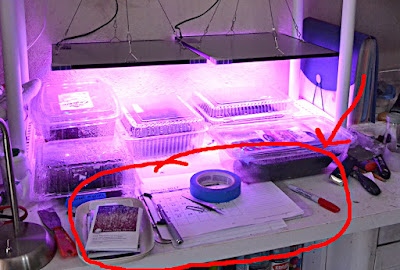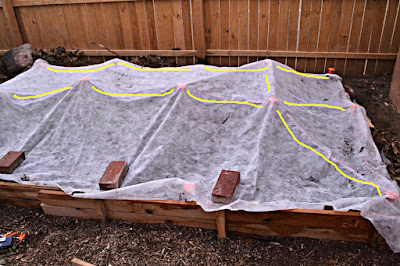Herbicides are chemicals used to control unwanted plants. All conventional or "organic" herbicides work by somehow interfering with plant growth. They may block photosynthesis and protein production, dry out the leaves, or destroy or inhibit root formation. Because different plant groups have different biochemical pathways, some herbicides can kill only one group and leave other groups unaffected. Other herbicides will kill a wider range of plants.
This means that you might be able to get rid of some plants and not kill the plants you want to keep. But it also means you have to take the time to find the right herbicide, read labels and apply the herbicide correctly.
WARNING: If something will kill "weeds", it might also kill "flowers", "lawns", "vegetables", "shrubs", "trees", "animals", and you.
Read the labels before you buy a product or open the container. Follow the instructions. What has been sprayed can't be unsprayed.
READ THE LABELS: Yes, that means YOU!
A typical herbicide label has several pages of cautions and warnings and instructions. The label will tell you how to safely handle the product, what plants to use the product on, and just as important, what not to use it on. You can read the labels online while you are deciding which product you need.
 |
Label from typical lawn weed killer.
They tell you what NOT to apply it to because it will kill those plants.
There is also a long list of weeds it has been tested against that it will kill
if you apply it according to the package directions. |
What are you killing, and for how long do you want it dead?
Classified by results, herbicides can be thought of as soil sterilizers, broad spectrum herbicides,
broad-leaf herbicides, grass herbicides, and pre-emergent herbicides. So your first step is to decide what effects you need, and identify the plants you want to kill. Then you can select which product of that class will work best for you.
Soil Sterilizer
A soil sterilizer prevents seed sprouting and regrowth from roots for a long period, months to years. It usually kills existing plants as well. This is the equivalent of "nuke it from orbit" for a gardener, and should be very carefully researched.
This is
not the product you want to apply to clear the weeds from where you plan to put a lawn or vegetable garden.
Broad Spectrum Herbicide
Affects almost every plant you spray, but will not prevent seeds from sprouting, or only has a short effect on seed sprouting. These are useful for killing off everything and replanting with the desired species. With care they can be used around established plants without harming them.
Glyphosate is in this class, as is horticultural (20%) vinegar, and that
stupid mix of salt, vinegar and dish soap.
Broad-Leaf Herbicide
Affects most plants with two seed leaves, also known as broad-leaf plants, but does not affect plants with one seed leaf, such as grass and corn. This is what you get in the herbicides to kill weeds in lawns.
TIP: Not all plants with grass-like leaves are immune to this class of herbicide. Some are not botanically a "grass" and others are just delicate varieties of a grass.
Grass Herbicide
This affect plants with one seed leaf or thin leaves, such as grass and corn, but does not affect plants with two seed leaves.
These are useful for killing grass in your shrubbery and rose beds or an orchard.
Pre-Emergent Herbicide
This is often sold as a "weed preventer" because it sounds more appealing than "pre-emergent herbicide". However it is labelled, it will prevent most seeds from germinating, so don't try to use it to keep weeds from sprouting in the vegetable bed or lawn you just seeded.
TIP:Timing is everything with pre-emergents. Applied too early or if there is too much rain and the herbicide might be washed below the level where the seeds are germinating. Applied too late and the weeds can be too mature to be affected.
On-Line References
https://en.wikipedia.org/wiki/Herbicide
http://extension.psu.edu/pests/weeds/control/introduction-to-weeds-and-herbicides/safe-herbicide-use
http://extension.psu.edu/pests/weeds/control/introduction-to-weeds-and-herbicides/herbicides
http://www.ocregister.com/articles/plants-80501-weed-herbicides.html
Read more!
















































